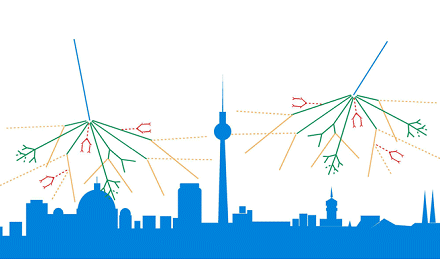URL: https://www.desy.de/school/school_lab/zeuthen_site/cosmic_particles/cosmicweb/index_eng.html
Breadcrumb Navigation
Cosmic@Web - Online Analysis Tools
Cosmic@Web - Online Analysis Tools

Without any programming knowledge and comfortably from a home laptop, pupils can now also work like an astroparticle physicist. Data from simplified cosmic rays experiments, most of which are carried out at DESY in Zeuthen, are integrated into Cosmic@Web and thus offer easy access to real long-term measurements.
When working in scientific research it is not always possible to have the experiment on-site. Especially the large-scale experiments researching particle and astroparticle physics are so complex and expensive, they are made only once in coordination of all involved science facilities. Examples of DESY's participations in such projects are the IceCube experiment in the Antarctica, the experiments at the Large Hadron Collider (LHC) at CERN and the planned Cherenkov Telescope Array (CTA). For astroparticle experiments additional aspects infringe the ability to build an experiment as space requirements, available infrastructure, annual weather conditions and scattered light play a significant role. Often several hours flight and travel time lie between the office and the research station. However, it is not always necessary to have your workplace next to the experiment. For the observation and investigation of cosmic particles, long-term measurements are particularly necessary in order to obtain suitable statistics and to derive significant statements. The measured data is therefore made available via the Internet so that it can be analyzed regardless of location. The scientists and technicians that travel to the locations of the experiment, mainly do so for maintenance and upgrade of the experimental facilities.
To expand the possibility of investigations with cosmic particles in the classroom and to reach a broader audience, the use of experimental data by students via the internet was introduced. DESY provides the internet portal Cosmic@Web which allows to analyse a large amount of data taken by different cosmic particle experiments running continuously at DESY, on the research vessel Polarstern and at the Antarctic station Neumayer III. A detailed description of the experiments, of the data structure, a proposal of interesting problems for students to investigate and a tutorial on how to use the web interface allow independent work. Students can analyse the data from the classroom or from home without direct contact to scientists. This offer is supported by the Gesamtmetall – Nachwuchssicherung and expands the spectrum of possibilities in the Netzwerk Teilchenwelt.
DESY, Zeuthen |
R/V Polarstern |
Neumayer Station III |
Aragats, Armenia |
Musala, Bulgaria |
Zugspitze, Germany |
|
|---|---|---|---|---|---|---|
Trigger Hodoscope |
||||||
CosMO-Mill |
||||||
LiDO |
||||||
Trigger Counter |
||||||
Neutron Monitor |
||||||
SEVAN-Detector |
||||||
Weather Data |
|
The table gives an overview of which experiments are continuously taking data and where they are located. Each of them measures a multitude of different physical quantities. Instructions on how to analyze this data and display dependencies can be found in the Documentation.
The data sets also contain weather conditions such as temperature and atmospheric pressure. The Polarstern data additionally contains the position information. Cosmic@Web provides a simple tool that allows the investigation of many interesting problems by creating graphs with the data taken over several years. A few of them are listed here:
- How does the cosmic particle rate depend on the angle of flight?
- What is the influence of the Earth's magnetosphere on the cosmic particle rate?
- Is it possible to detect Solar flares on the Earth's surface?
- How long do muons "live"?
On the following pages the different experiments will be introduced and examples of student exercises and investigations can be found.
But generally, the motto is: You've got an idea? Try it!


